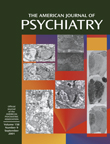Normal PET After Long-Term ECT
Ms. A, a physically healthy 42-year-old woman, was admitted to our hospital with a diagnosis of a severe major depressive episode (according to DSM-IV criteria) and an initial score on the Hamilton Depression Rating Scale (17-item version) of 36. She had suffered from at least nine severe major depressive episodes (intermittently with psychotic features) since 1987. Relapses occurred despite consequent pharmacological continuation treatment. Ms. A had been treated with high doses of tranylcypromine (80 mg/day) during the last few years, but she had not recovered. The addition of newer antidepressant drugs (e.g., mirtazapine, 30 mg/day) and different augmentation strategies (e.g., with lithium) over long periods of time had been ineffective.A trial of ECT (three times a week, a total of nine sessions) had been conducted in 1995; Ms. A had good results after three applications. Because of the high risk of relapse, maintenance treatment with ECT in combination with tranylcypromine was administered for 6 months, during which Ms. A did well. Treatment was of short duration because of the lack of controlled studies combining long-term ECT with tranylcypromine. Continuation treatment remained an issue; Ms. A had periods of remission lasting only 10–12 months during the next several years. Nevertheless, ECT continued to be a highly efficacious and tolerable treatment option during acute depression owing to its short latency of action.After we performed cerebral magnetic resonance imaging, which showed no abnormalities, we performed an FDG PET scan while Ms. A was still severely depressed, to exclude metabolic abnormalities possibly associated with the high number of previous ECT treatments. The scanning was performed under standard resting conditions, and the data were compared to data from an age-matched comparison group (N=20) on a pixelwise basis by means of an observer-independent analytical approach (3). This statistical subtraction analysis did not identify any areas with differences in glucose metabolism of more than two standard deviations from those in the normal database. This method has been proven to be extremely sensitive in detecting abnormalities. Thus, Ms. A’s glucose metabolism was regarded as normal. ECT was reinstituted. After nine sessions of brief-pulse unilateral ECT treatments, Ms. A had completely recovered and was discharged with a Hamilton depression scale score of 4.
References
Information & Authors
Information
Published In
History
Authors
Metrics & Citations
Metrics
Citations
Export Citations
If you have the appropriate software installed, you can download article citation data to the citation manager of your choice. Simply select your manager software from the list below and click Download.
For more information or tips please see 'Downloading to a citation manager' in the Help menu.
There are no citations for this item
View Options
View options
PDF/ePub
View PDF/ePubGet Access
Login options
Already a subscriber? Access your subscription through your login credentials or your institution for full access to this article.
Personal login Institutional Login Open Athens loginNot a subscriber?
PsychiatryOnline subscription options offer access to the DSM-5-TR® library, books, journals, CME, and patient resources. This all-in-one virtual library provides psychiatrists and mental health professionals with key resources for diagnosis, treatment, research, and professional development.
Need more help? PsychiatryOnline Customer Service may be reached by emailing [email protected] or by calling 800-368-5777 (in the U.S.) or 703-907-7322 (outside the U.S.).

